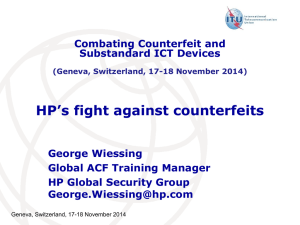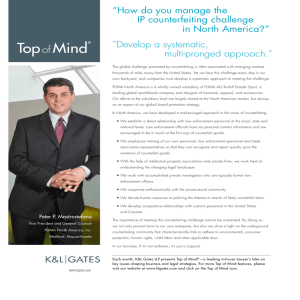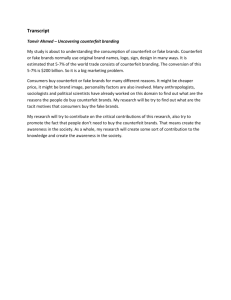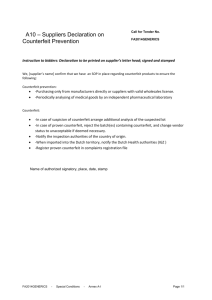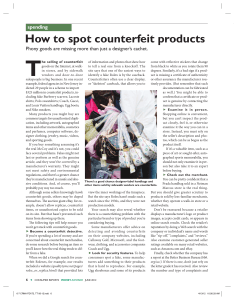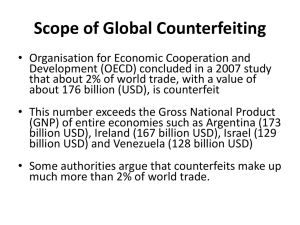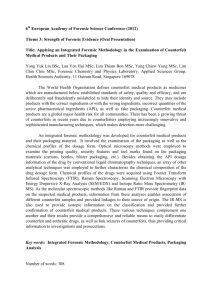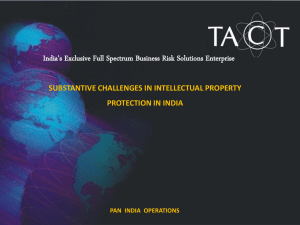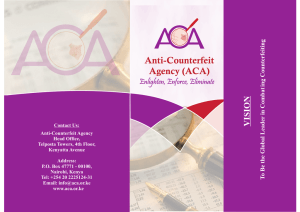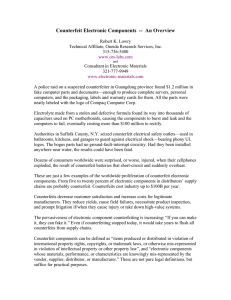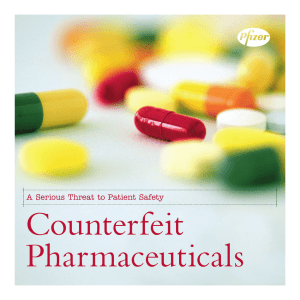Counterfeits A growing problem in international trade.
advertisement
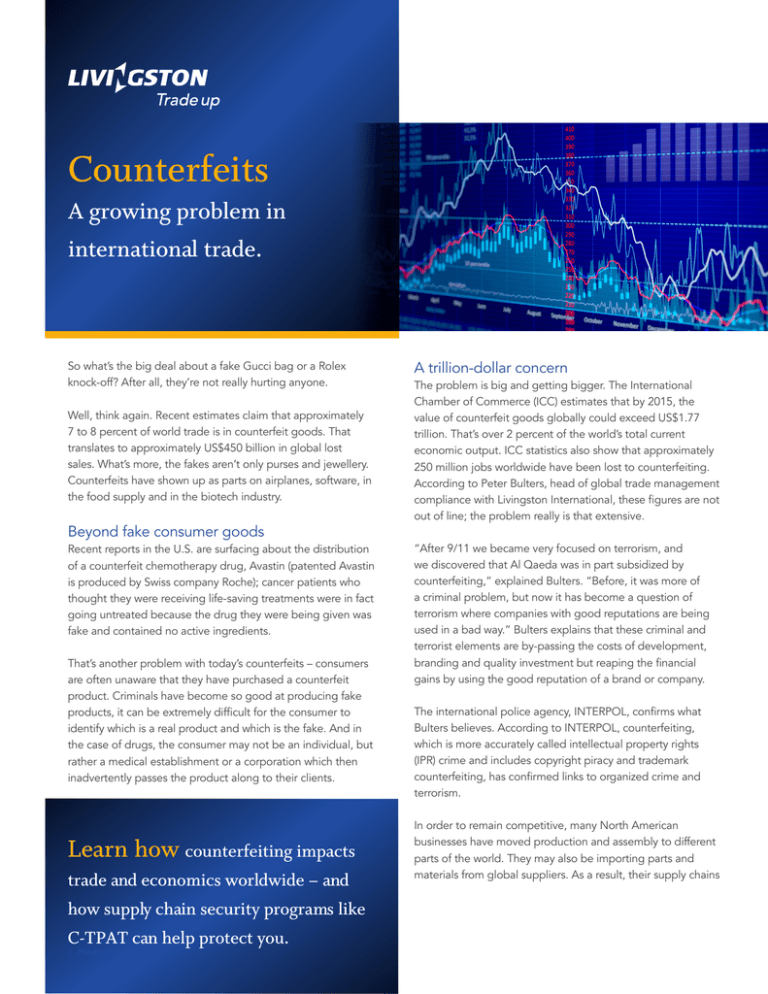
Counterfeits A growing problem in international trade. So what’s the big deal about a fake Gucci bag or a Rolex knock-off? After all, they’re not really hurting anyone. Well, think again. Recent estimates claim that approximately 7 to 8 percent of world trade is in counterfeit goods. That translates to approximately US$450 billion in global lost sales. What’s more, the fakes aren’t only purses and jewellery. Counterfeits have shown up as parts on airplanes, software, in the food supply and in the biotech industry. A trillion-dollar concern The problem is big and getting bigger. The International Chamber of Commerce (ICC) estimates that by 2015, the value of counterfeit goods globally could exceed US$1.77 trillion. That’s over 2 percent of the world’s total current economic output. ICC statistics also show that approximately 250 million jobs worldwide have been lost to counterfeiting. According to Peter Bulters, head of global trade management compliance with Livingston International, these figures are not out of line; the problem really is that extensive. Beyond fake consumer goods Recent reports in the U.S. are surfacing about the distribution of a counterfeit chemotherapy drug, Avastin (patented Avastin is produced by Swiss company Roche); cancer patients who thought they were receiving life-saving treatments were in fact going untreated because the drug they were being given was fake and contained no active ingredients. That’s another problem with today’s counterfeits – consumers are often unaware that they have purchased a counterfeit product. Criminals have become so good at producing fake products, it can be extremely difficult for the consumer to identify which is a real product and which is the fake. And in the case of drugs, the consumer may not be an individual, but rather a medical establishment or a corporation which then inadvertently passes the product along to their clients. Learn how counterfeiting impacts trade and economics worldwide – and how supply chain security programs like C-TPAT can help protect you. 1 Product: Export Process “After 9/11 we became very focused on terrorism, and we discovered that Al Qaeda was in part subsidized by counterfeiting,” explained Bulters. “Before, it was more of a criminal problem, but now it has become a question of terrorism where companies with good reputations are being used in a bad way.” Bulters explains that these criminal and terrorist elements are by-passing the costs of development, branding and quality investment but reaping the financial gains by using the good reputation of a brand or company. The international police agency, INTERPOL, confirms what Bulters believes. According to INTERPOL, counterfeiting, which is more accurately called intellectual property rights (IPR) crime and includes copyright piracy and trademark counterfeiting, has confirmed links to organized crime and terrorism. In order to remain competitive, many North American businesses have moved production and assembly to different parts of the world. They may also be importing parts and materials from global suppliers. As a result, their supply chains The impact of counterfeits: have become longer and more complicated, making it difficult to control and audit, and even to track an imported good back to its source. This has left the door open for IPR crime. “In countries where there are fewer controls, it’s easier to manufacture something that isn’t tested or certified,” said Bulters. Both India and China have been cited as the largest producers of counterfeit goods, in part because both countries are large exporters, and also because of the large number of factories in the two nations. In fact, 2011 statistics from Canada’s RCMP show that in cases where the origin of the counterfeit coming into Canada was identified, 80 percent of these goods came from China. • 7-8 percent of world trade is in counterfeit goods • Counterfeits account for US$450 billion in global lost sales • By 2015, the value of counterfeit goods could reach US$1.7 trillion “Just like when you are fighting any form of terrorism, the key is to secure the entire supply chain. This is the only way to avoid counterfeit goods,” said Bulters. Bulters stresses the value of supply chain security programs such as the U.S. Customs-Trade Partnership Against Terrorism (C-TPAT), Canada’s Partners in Protection (PIP) or, on a global scale, the World Customs Organization (WCO) SAFE Framework. “You need cooperation between business and government,” he stated. Statistics show that approximately 250 million jobs worldwide have been lost to counterfeiting. Investing in security Businesses that enroll in these programs may initially balk at the cost and the strict requirements, but will reap the rewards in the long run, said Bulters. A recent survey conducted by U.S. Customs and Border Protection (CBP) on the costs and benefits of C-TPAT showed that most participants find that many of the benefits of the program cannot be measured in terms of dollars. Respondents to CBP’s survey cited the benefits of being a good corporate citizen, of having faith that the products they were bringing into the marketplace were safe and of good quality, and of having confidence that their supply chain partners met the same high standards they themselves had set. Increased vigilance and enhanced security across the entire supply chain are the only way to limit the production and infiltration of counterfeits into the supply chain. This is critical for businesses looking to safeguard their reputation for safe, high quality goods. With both Canada and the U.S. focused on consumer product safety issues, the focus on counterfeit goods is only going to become more intense… and while a fake Gucci or Rolex may not cause anyone direct harm, the industry that produces them could be one of the largest threats facing both businesses and governments worldwide. Contact your Livingston account executive e-mail us at solutions@livingstonintl.com or give us a call at 1-800-837-1063 Visit www.livingstonintl.com 2 Counterfeits: A growing problem in international trade
